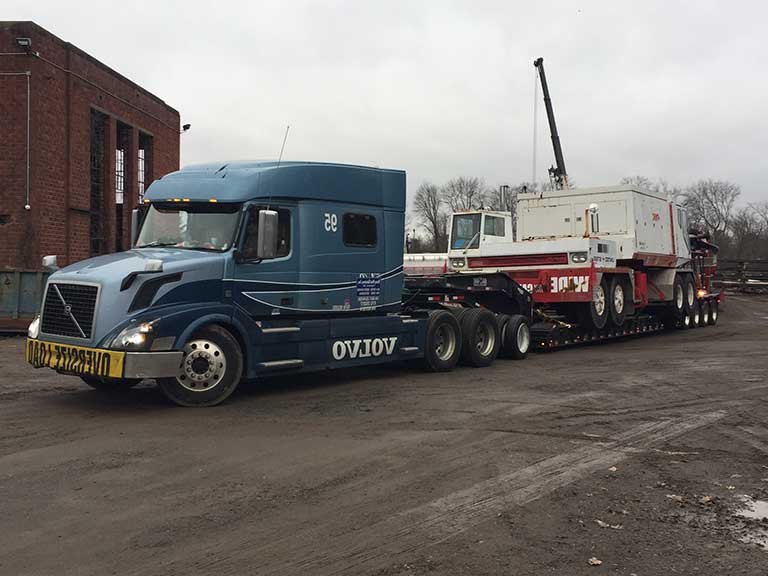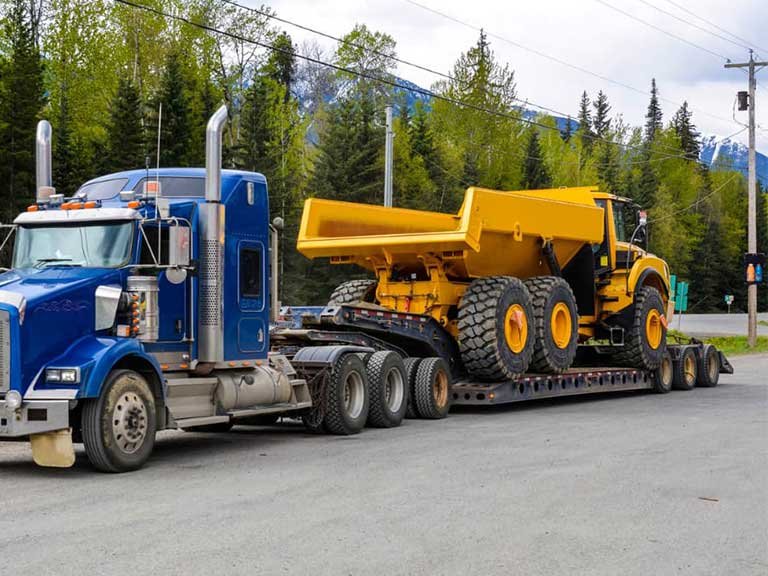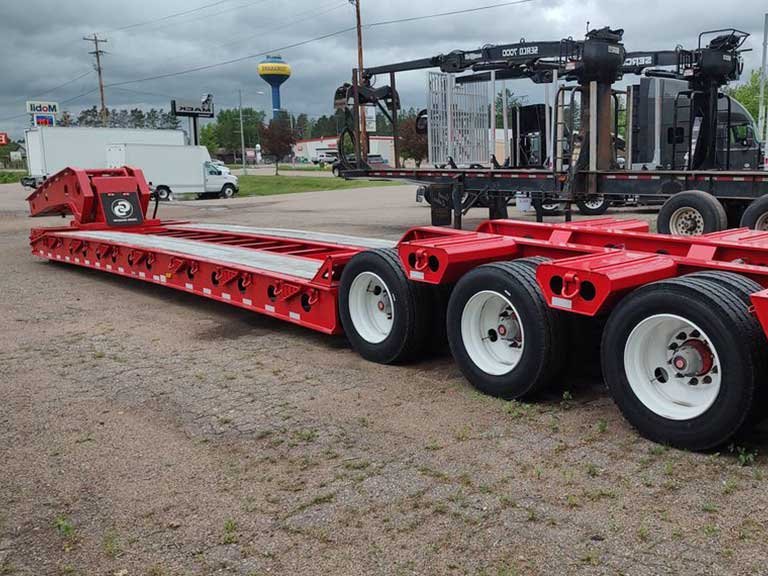Lowbed trailers are made for moving heavy and oversized equipment. But a lowboy trailer’s load capacity can differ a lot. This varies based on several factors, like the trailer’s design and setup.
Knowing the load capacity limits is key for safe and legal transport of heavy machinery. In this guide, we’ll look at what affects a lowboy trailer’s load capacity. We’ll also talk about how to pick the right trailer for your needs.
Table of Contents
Understanding Lowboy Trailer Capacity
Knowing a lowboy trailer’s capacity is vital for safe and efficient transport of heavy equipment. At Genron International Trade, we know how important it is to choose the right lowbed trailer. This is especially true for our clients across Africa and Southeast Asia.
- What Determines the Load Capacity: A lowboy trailer’s load capacity depends on several key factors. These include its axle setup, construction material, and design. The payload capacity can vary a lot based on these factors. We make lowboy trailers with customized weights for our clients in construction, mining, and industry.
- Standard Weight Ranges: Commercial lowboy trailers have payload capacities that change with their axle setup. Standard 2-axle models can carry up to 25 tons (50,000 lbs). 3-axle models can handle up to 55 tons (110,000 lbs). Specialized models with more axles can carry even more, up to 100 tons.
Our trailers are designed to meet our clients’ needs, with models for specific heavy equipment types. We also consider legal weight limits by region, ensuring our trailers stay within common GVWRs. This way, we provide trailers that exactly match our clients’ needs, whether for construction, mining, or other heavy equipment transport.
Begin with a bespoke semi-trailer designed for your exact needs. Whether it’s heavy-duty hauling or specialized cargo, we’ve got the perfect solution to keep you moving forward.
Types of Lowboy Trailers and Their Load Capabilities
It’s important to know the different types of lowboy trailers and their load capacities. Lowboy trailers are made for heavy loads, but their capacity changes based on their setup and design.
- Fixed Gooseneck (FGN) Lowboy Trailers: Fixed Gooseneck Lowboy Trailers are stable and can carry heavy loads, usually between 30-50 tons. They’re great for heavy equipment that doesn’t need the gooseneck removed often.
- Removable Gooseneck (RGN) Lowboy Trailers: Removable Gooseneck Lowboy Trailers are flexible, with capacities often between 40-60 tons. They’re good for loads that need the gooseneck removed for easier loading and unloading.
- Hydraulic Detachable Gooseneck (HDG) Lowboy Trailers: Hydraulic Detachable Gooseneck Lowboy Trailers use hydraulic systems for easy gooseneck detachment. They usually carry between 35-55 tons. Their ease of use and versatility make them popular.
- Mechanical Detachable Gooseneck (MDG) Lowboy Trailers: Mechanical Detachable Gooseneck Lowboy Trailers use manual systems for detachment. They offer a balance of functionality and simplicity. Their capacities range from 35-55 tons, making them suitable for heavy loads in tough environments.
Key Factors That Determine Lowboy Trailer Load Capacity
Knowing what affects a lowboy trailer’s load capacity is key for the safe transport of heavy gear. The capacity isn’t just a number; it’s shaped by design, materials, and engineering.
- Axle Configuration and Weight Distribution: The axles’ setup is vital for a lowboy trailer’s load capacity. How weight spreads across the axles affects stability and load-carrying ability. Our trailers are designed for optimal axle setups to boost capacity safely and meet regulations.
- Deck Length and Width Considerations: The deck’s size is a big deal for a lowboy trailer’s load capacity. A bigger deck can handle larger, heavier loads. But, it needs careful design to keep it strong and stable. We aim for a balance between size, stability, and ease of use.
- Material Construction and Structural Integrity: The materials and design of the trailer are key to its load capacity. We use high-strength steel to carry heavy loads without losing durability. Advanced welding makes our trailers even stronger.
We focus on these factors to make sure our trailers can safely carry heavy loads. This meets our customers’ needs while keeping quality and reliability high.

Calculating the Right Lowboy Trailer Load for Your Equipment
To find the perfect lowboy trailer load for your gear, you must think about a few key things. These things help keep everything safe and running smoothly. At Genron International Trade, we make our lowboy trailers with safety and performance in mind. We make sure they meet the highest standards for moving heavy equipment.
- Determining Equipment Weight and Dimensions: The first step is to figure out the weight and size of your equipment. You need to measure its length, width, height, and total weight. Getting these measurements right is key to making sure your equipment is safely and evenly placed on the trailer.
- Accounting for Additional Accessories and Attachments: Don’t forget to include any extra parts or attachments when figuring out the trailer load. This includes things like chains, binders, and other securing tools. These add to the weight and affect how stable the trailer is.
- Safety Margins and Weight Distribution Principles: Transporters usually add a 10-15% safety margin below the max capacity. This is to handle unexpected weight changes and forces during transport. It’s also important to spread the weight evenly. The best way is to put 25-30% of the weight on the kingpin and the rest on the axles.
Proper Loading Techniques for Lowboy Trailers
Safe transport of heavy equipment requires the right loading techniques for lowboy trailers. At Genron International Trade, we stress the importance of careful planning and execution. This helps prevent accidents and follows all rules.
- Step-by-Step Loading Process: There are several important steps to load heavy equipment onto a lowboy trailer. First, check the equipment’s weight and size to make sure it fits the trailer. Then, place the equipment on the trailer, making sure the weight is evenly distributed. Finally, use the right tie-downs and chains to secure it.
- Securing Heavy Equipment Safely: Securing the equipment is a big part of the loading process. Use enough tie-down points and the right chain grades to keep the cargo in place during transport. Think about how braking, acceleration, and turning affect the cargo to ensure it’s transported safely and stably.
Common Loading Mistakes to Avoid
There are a few common mistakes that can make the loading process unsafe. These include:
- Improper weight distribution can lead to trailer tipping or loss of control.
- Inadequate securement, resulting from insufficient tie-down points or improper chain grades.
- Neglecting to remove or secure detachable components creates hazards during transport.
- Exceeding the trailer’s rated capacity, increasing structural stress, and compromising safety margins.
By following these guidelines and avoiding these mistakes, operators can ensure the safe and compliant transport of heavy equipment on lowboy trailers.

Specialized Lowboy Trailers for Extreme Heavy Loads
Lowboy trailers for extremely heavy loads have special features for safe and efficient transport. At Genron International Trade, we offer customized lowboy trailer solutions for unique challenges. This is especially true for our clients in Africa and Southeast Asia.
Multi-axle configurations boost the load capacity of lowboy trailers. By spreading the weight across multiple axles, these trailers can carry heavier loads while still following road rules.
Custom Lowboy Solutions for Oversized Equipment
Custom lowboy trailers are made for oversized equipment. They have features like hydraulically widening decks and telescoping lengths. These help in safely moving large and heavy loads.
- Hydraulically widening decks expand from legal width to over 14 feet. This gives stability during transport.
- Perimeter deck designs lower the deck height. This can help avoid height permits.
- Dual-lane trailers can handle extreme weights. They can carry loads over 300 tons.
- Telescoping trailers adjust in length. They can extend to over 80 feet for long loads.
We work with clients to design trailers for their needs. This ensures efficient and compliant transport.
Maintenance Considerations for Maximum Load Capacity
Regular maintenance is key to keeping lowboy trailers at their best. Proper care ensures they work as designed and last longer.
- Regular Inspection Requirements: Regular checks are important to catch issues early. We suggest inspecting axles, brakes, and suspension often. This prevents failures during use.
- Tire and Suspension Maintenance for Heavy Loads: Keeping tires and suspension in good shape is crucial for heavy loads. Proper tire pressure and regular checks ensure even weight distribution and a smooth ride.
- Structural Integrity Checks and Repairs: Checking the trailer’s structure is vital. Look for damage or wear on the deck, beams, and connections. Quick repairs, like welding, are needed to keep the trailer’s capacity.
| Maintenance Task | Frequency | Importance |
| Regular Inspection | Every 1,000 miles | High |
| Tire Pressure Check | Weekly | High |
| Suspension System Check | Every 5,000 miles | High |
| Structural Integrity Check | Every 10,000 miles | Critical |

Conclusion
Choosing a lowboy trailer needs careful thought. Consider load capacity and weather conditions. At Genron International Trade, we know the right trailer is key for moving heavy equipment.
Think about your typical and maximum load weights, equipment size, and routes. The best trailer balances load capacity and flexibility. Consider deck height and width for oversized cargo.
The weather in Africa and Southeast Asia affects trailer choice. Our customization meets specific needs, offering better value than standard models. A well-chosen lowboy trailer ensures reliability, compliance, and safety. For a custom quote, contact our engineering team today.


